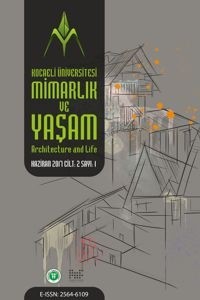Mimarlıkta Yapı Dersleri Müfredatı Dijital Dönüşüm Modeli
Sanal gerçeklik, Artırılmış gerçeklik, Yapı bilgi modelleme, Mimarlık eğitimi, Yapı dersleri
Digital Transformation Model for Building Construction Curriculum in Architecture
Virtual reality, Augmented reality, Building Information Modelling, Architectural education, Building construction courses,
___
- Arashpour, M., Sagoo, A., Wingrove, D., Maqsood, T. ve Wakefield, R. (2015). Single capstone or multiple cornerstones? Distributed model of capstone subjects in construction education, 8th International Structural Engineering and Construction Conference: Implementing Innovative Ideas in Structural Engineering and Project Management, ISEC Press.
- Arashpour, M. ve Aranda-Mena, G. (2017). Curriculum renewal in architecture, engineering, and construction education: visualizing building information modeling via augmented reality, Proceedings of International Structural Engineering and Construction, Vol. 4 No. 1, doi: 10.14455/ ISEC.res.2017.54.
- Bloom, B. (1956). Bloom’s taxonomy.
- Coates, P., Arayici, Y., Koskela, L., Kagioglou, M., Usher, C., ve O'Reilly, K. (2010). The limitations of BIM in the architectural process, ICSU 2010, China. 15-17 Dec.
- Dalgarno, B. ve Lee, M.J.W. (2010). What are the learning affordances of 3-D virtual environments?, British Journal of Educational Technology, Vol. 41 No. 1, pp. 10-32, doi: 10.1111/j.1467- 8535.2009.01038.x.
- Diao, P. ve Shih, N. (2019). Trends and research issues of augmented reality studies in architectural and civil engineering education – a review of academic journal publications, Applied Sciences, Vol. 9 No. 9, p. 1840, doi: 10.3390/app9091840.
- Duit, R. (1996). The constructivist view in science education–what it has to offer and what should not be expected from it. Investigaçôes em ensino de ciências, 1(1), 40-75.
- ECSO (2021). Digitalisation in the Construction Sector Analytical Report, European Construction Sector Observatory, available at: https://ec.europa.eu/docsroom/documents/45547.
- Emre, İ.E., Selçuk, M., Budak, V.Ö, Bütün M. ve Şimşek, İ. (2019). Eğitim Amaçlı Sanal Gerçeklik Uygulamalarında Kullanılan Cihazların Daldırma Açısından İncelenmesi. Bilişim Teknolojileri Dergisi. 2, 119-129.
- Horne, M. ve Thompson, E.M. (2008). The role of virtual reality in built environment education, Journal for Education in the Built Environment, Vol. 3 No. 1, pp. 5-24, doi: 10.11120/ jebe.2008.03010005.
- Kızılyaprak, H.N., Altun, M. C. (2019). Türkiye’deki Mimari Teknoloji Eğitimine Yönelik Bir Analiz. Mimarlık ve Yaşam Dergisi, 4(1), 39-53. doi: 10.26835/my.491641.
- Kurt, S. (2011). Use of constructivist approach in architectural education. Procedia-Social and Behavioral Sciences, 15, 3980-3988. Mala, K. ve Singh, N. (2017). Constructivist approach: a way of learning. GHG Journal of Sixth Thought Vol. 4 No.2 McKinsey Raporu (2020), The Next Normal in Construction, available at: https://www.mckinsey.com/∼/media/McKinsey/Industries/Capital%20Projects%20and%20Infrastructure/Our%20Insights/The%20next%20normal%20in%20construction/The-next-normal-in-construction. pdf
- Milgram, P. and Kishino, F. (1994). A taxonomy of mixed reality visual displays, IEICE Transactions on Information and Systems, Vol. 77 No. 12, pp. 1321-1329.
- Sawhney, A., Riley, M. and Irizarry, J. (2020). Construction 4.0: An Innovation Platform for the Built Environment, Routledge, London, ISBN 9780367027308.
- Seyman Güray, T ve Kısmet, B. (2021). Applicability of a Digitalization Model based on Augmented Reality for Building Construction Education in Architecture. Construction Innovation: Information, Process, Management. https://doi.org/10.1108/CI-07-2021-0136
- Wang, P., Wu, P., Wang, J., Chi, H.A. ve Wang, X. (2018). A critical review of the use of virtual reality in construction engineering education and training, International Journal of Environmental Research and Public Health, Vol. 15 No. 6, doi: 10.3390/ijerph15061204.
- ISSN: 2564-6109
- Başlangıç: 2016
- Yayıncı: Kocaeli Üniversitesi
Biyomimetrik Yapı Malzemeleri ile Post Pandemik Döneme Uygun İç Mekanlar Tasarlanması
Mimarlıkta Yapı Dersleri Müfredatı Dijital Dönüşüm Modeli
Tayibe SEYMAN GURAY, Burcu KISMET
Sekanslar Yoluyla Mekânsal Bütünlük: Mimari Tasarım İçin Çağdaş Senaryo Planlama Teknikleri
Yeniden İşlevlendirilen Endüstri Mirası Yapılar için İç Mekân Kavramsal Önerileri
Van Kent Yapı Stokunun Mimari Özellikleri ve Mühendislik Uygulamaları Üzerine Bir Değerlendirme
Dolgu Duvarlı Çerçevelerde Sıvanın Deprem Davranışına Katkısı
Safranbolu Eski Çarşı Bölgesinde Mekanın Tüketim Ekseninde İrdelenmesi
Sebile Merve ÖZTÜRK, Ruşen YAMAÇLI
Yüzen Evlerde Sürdürülebilirlik Kavramı
Filiz TAVŞAN, Sümeyye PERVANOĞLU, Cengiz TAVŞAN
Yerel Mimaride Değişimler/Dönüşümler: Sırt Mahallesi Örneği (Rize-İkizdere/Türkiye)
